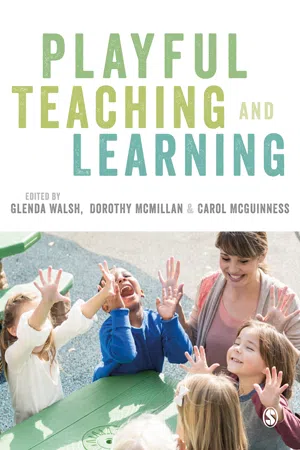
eBook - ePub
Playful Teaching and Learning
Glenda Walsh,Dorothy McMillan,Carol McGuinness
This is a test
Share book
- 240 pages
- English
- ePUB (mobile friendly)
- Available on iOS & Android
eBook - ePub
Playful Teaching and Learning
Glenda Walsh,Dorothy McMillan,Carol McGuinness
Book details
Book preview
Table of contents
Citations
About This Book
Every early years practitioner should be able to captivate and maintain the interest of young children in their setting, through the provision of a playful learning experience.
Covering age ranges 3-8 years, this textbook explores the importance of infusing playfulness throughout the entire early years day, and includes chapters that:
- establish the core principles underpinning playful teaching and learning
- help students and practitioners understand how playfulness can be applied to all aspects of the early years curriculum including mathematics, literacy, outdoor environments, science & technology, and ICT
- explore core issues in early years provision including observing, planning & assessment, and how they relate to playful learning
- emphasise the role and qualities of the playful professional.
This is a fantastic resource for any student or practitioner looking to enrich the lives of young children through meaningful playful learning experiences.
Frequently asked questions
How do I cancel my subscription?
Can/how do I download books?
At the moment all of our mobile-responsive ePub books are available to download via the app. Most of our PDFs are also available to download and we're working on making the final remaining ones downloadable now. Learn more here.
What is the difference between the pricing plans?
Both plans give you full access to the library and all of Perlego’s features. The only differences are the price and subscription period: With the annual plan you’ll save around 30% compared to 12 months on the monthly plan.
What is Perlego?
We are an online textbook subscription service, where you can get access to an entire online library for less than the price of a single book per month. With over 1 million books across 1000+ topics, we’ve got you covered! Learn more here.
Do you support text-to-speech?
Look out for the read-aloud symbol on your next book to see if you can listen to it. The read-aloud tool reads text aloud for you, highlighting the text as it is being read. You can pause it, speed it up and slow it down. Learn more here.
Is Playful Teaching and Learning an online PDF/ePUB?
Yes, you can access Playful Teaching and Learning by Glenda Walsh,Dorothy McMillan,Carol McGuinness in PDF and/or ePUB format, as well as other popular books in Éducation & Éducation de la petite enfance. We have over one million books available in our catalogue for you to explore.
Information
Section 1 Principles of Playful Teaching and Learning
1 Why Playful Teaching and Learning?
Chapter Overview

This chapter will take you on an evidence-based journey to show you why play in practice needs to be reconceptualised. To ensure that 3–8 year old children learn more effectively in setting-based contexts, we need to think differently about play and what it means for learning – and that is the purpose of this first chapter. Before embarking on the substance of the chapter, take time to read the introductory case study as it presents the essence of what the chapter is about.
Case Study 1.1: Lillyfield Primary School’s Playtime

Like every morning, Mrs B got the children around her and began to recite the different play areas that were available for the children to play with that morning. “Today, boys and girls, you have the house corner, but I don’t want to see the same silliness as yesterday – no bringing in the dough or water – you can pretend to wash the dishes and to make cakes – sure that is what it is all about”. She then continued to explain where else the children could play including small world dinosaur play, construction using Lego, making birthday cakes with the dough and the writing corner where today children were having the opportunity to make Mother’s Day cards. After approximately 20 minutes sitting and waiting, the 26 children were finally released to go and play in the area to which they had been assigned. Bertie and Bob were at the dinosaurs – the area they had been waiting for all week – six dinosaurs of different shapes and sizes set inside a shoe box, filled with some leaves. The boys started off making roaring sounds and then bouncing the dinosaurs in the shoebox as if they were ready to attack. The play soon developed into a dinosaur fight, becoming raucous and noisy. At first Mrs B tried to ignore what they were doing, but soon realised that she would have to intervene by asking the boys to play more quietly or she would have to move them elsewhere. In an attempt to bring them back on task, she asked then to name each dinosaur in turn and then to count how many there were. After she moved on, the boys returned to their loud and somewhat aggressive and chaotic play, but after 5 minutes they then decided to move to the dough table, where they rolled out a circle shape and stuck a candle on the top. Mrs B then called them over to the writing table to make a Mother’s Day card, with the help of Miss F (the classroom assistant), as there was only 5 minutes until tidy up time.
This is the story of playtime at Lillyfield primary school. Although the observation took place some years ago (in 2010), the story is still very relevant today in many of our early years settings. Play is taking place and, as early years educationalists, we should be delighted about this; but in many cases the play lacks richness, challenge and adventure. In many of our educational settings, play has become reduced to routine and mundane practical tasks, where educators appear confused and lack understanding about what their role in play should be in an effort to foster learning and indeed what play as learning should look like in practice. In this chapter I intend to examine more carefully why many early years educators face these dilemmas and then create a rationale for why play in practice needs to be reconceptualised as pedagogy – moving away from an overly maturistic and child-led approach to play towards aligning play, learning and teaching more closely and proposing the concept of Playful Teaching and Learning as the way forward.
Origins of Play as Learning
The importance of play for young children’s learning and development has long been recognised, emanating from the pioneering work of eminent scholars and philanthropists such as Rousseau, Fröbel and Pestalozzi. From as early as the eighteenth century, play has been deemed as highly serious and of deep significance for children. It has been promoted as the medium through which young children learn best and through which the ‘whole’ child is fully developed. Contemporary research confirms the thinking of these early pioneers, drawing on a range of evidence that suggests that play educates emotionally, socially, cognitively and physically (e.g., Whitebread et al., 2012). The lasting social and emotional benefits of play have long been established in a number of longitudinal experimental studies (e.g., Schweinhart and Weikart, 1997). These studies demonstrate that engaging in more play-based and developmentally appropriate curricula in those formative early years of education has positive effects on children’s interpersonal and negotiation strategies, on their personal relationships and community behaviour, on their ability to deal with stress and emotional issues, as well as their overall academic aspirations.
More recent evidence has also been accruing on the power of play-based activity in fostering children’s dispositional and cognitive skills. Play, it appears, can provide opportunities for children to engage in self-regulation, to solve problems, to advance their motivation and concentration and to develop their independence and metacognitive powers (e.g., Walsh et al., 2006). A further small but growing body of evidence links play directly to children’s ability to master academic skills such as literacy and numeracy. For example, researchers have found that engagement in dramatic play and acting out stories prompted their metalinguistic ability, helping children to recognise the components of stories and improve their text comprehension (Christie and Roskos, 2006). Likewise, evidence would suggest that children’s early experimentation, observation and comparison in their play impacts on children’s later learning of STEM (Science, Technology, Engineering and Maths) (Bergen, 2009). With regard specifically to mathematics, research by Carruthers and Worthington (2006) has highlighted that play involving counting and other basic mathematical operations supports young children’s ability to engage in formal mathematics more confidently.
The physicality associated with play-based activity has also received growing significance in terms of children’s health, well-being (Hope et al., 2007) and cognitive development (Pellegrini and Holmes, 2006). Jarvis’ findings (2010) (focusing particularly on rough and tumble play) reveal that much social and gender role development is mediated through physical play experiences, while a literature review by Campbell and Hesbeth (2007) proposes a link between physical activity beginning in early childhood and the prevention of obesity in later years.
In this way, it could be argued that play, in its highest form, can provide for the holistic development of the young child in its widest sense, that is, socially, emotionally, cognitively and physically.
Pause for Thought
The evidence described above emphasises the many benefits of play in practice for young children’s learning and development. Why, in your opinion, can play be such a powerful learning medium for young children?
Challenges of Play as Learning in Practice
Against this understanding of play being beneficial for young children’s learning and development, is a portrayal o...